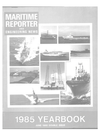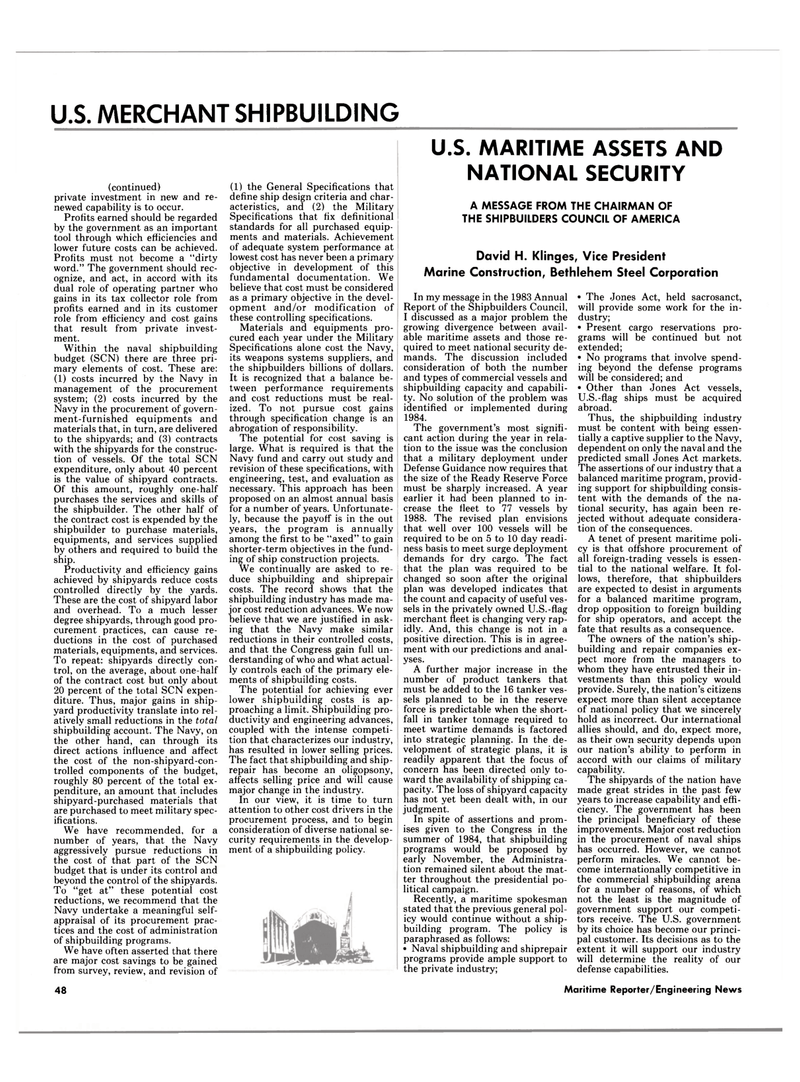
Page 50: of Maritime Reporter Magazine (June 1985)
Read this page in Pdf, Flash or Html5 edition of June 1985 Maritime Reporter Magazine
U.S. MERCHANT SHIPBUILDING (continued) private investment in new and re- newed capability is to occur.
Profits earned should be regarded by the government as an important tool through which efficiencies and lower future costs can be achieved.
Profits must not become a "dirty word." The government should rec- ognize, and act, in accord with its dual role of operating partner who gains in its tax collector role from profits earned and in its customer role from efficiency and cost gains that result from private invest- ment.
Within the naval shipbuilding budget (SCN) there are three pri- mary elements of cost. These are: (1) costs incurred by the Navy in management of the procurement system; (2) costs incurred by the
Navy in the procurement of govern- ment-furnished equipments and materials that, in turn, are delivered to the shipyards; and (3) contracts with the shipyards for the construc- tion of vessels. Of the total SCN expenditure, only about 40 percent is the value of shipyard contracts.
Of this amount, roughly one-half purchases the services and skills of the shipbuilder. The other half of the contract cost is expended by the shipbuilder to purchase materials, equipments, and services supplied by others and required to build the ship.
Productivity and efficiency gains achieved by shipyards reduce costs controlled directly by the yards.
These are the cost of shipyard labor and overhead. To a much lesser degree shipyards, through good pro- curement practices, can cause re- ductions in the cost of purchased materials, equipments, and services.
To repeat: shipyards directly con- trol, on the average, about one-half of the contract cost but only about 20 percent of the total SCN expen- diture. Thus, major gains in ship- yard productivity translate into rel- atively small reductions in the total shipbuilding account. The Navy, on the other hand, can through its direct actions influence and affect the cost of the non-shipyard-con- trolled components of the budget, roughly 80 percent of the total ex- penditure, an amount that includes shipyard-purchased materials that are purchased to meet military spec- ifications.
We have recommended, for a number of years, that the Navy aggressively pursue reductions in the cost of that part of the SCN budget that is under its control and beyond the control of the shipyards.
To "get at" these potential cost reductions, we recommend that the
Navy undertake a meaningful self- appraisal of its procurement prac- tices and the cost of administration of shipbuilding programs.
We have often asserted that there are major cost savings to be gained from survey, review, and revision of (1) the General Specifications that define ship design criteria and char- acteristics, and (2) the Military
Specifications that fix definitional standards for all purchased equip- ments and materials. Achievement of adequate system performance at lowest cost has never been a primary objective in development of this fundamental documentation. We believe that cost must be considered as a primary objective in the devel- opment and/or modification of these controlling specifications.
Materials and equipments pro- cured each year under the Military
Specifications alone cost the Navy, its weapons systems suppliers, and the shipbuilders billions of dollars.
It is recognized that a balance be- tween performance requirements and cost reductions must be real- ized. To not pursue cost gains through specification change is an abrogation of responsibility.
The potential for cost saving is large. What is required is that the
Navy fund and carry out study and revision of these specifications, with engineering, test, and evaluation as necessary. This approach has been proposed on an almost annual basis for a number of years. Unfortunate- ly, because the payoff is in the out years, the program is annually among the first to be "axed" to gain shorter-term objectives in the fund- ing of ship construction projects.
We continually are asked to re- duce shipbuilding and shiprepair costs. The record shows that the shipbuilding industry has made ma- jor cost reduction advances. We now believe that we are justified in ask- ing that the Navy make similar reductions in their controlled costs, and that the Congress gain full un- derstanding of who and what actual- ly controls each of the primary ele- ments of shipbuilding costs.
The potential for achieving ever lower shipbuilding costs is ap- proaching a limit. Shipbuilding pro- ductivity and engineering advances, coupled with the intense competi- tion that characterizes our industry, has resulted in lower selling prices.
The fact that shipbuilding and ship- repair has become an oligopsony, affects selling price and will cause major change in the industry.
In our view, it is time to turn attention to other cost drivers in the procurement process, and to begin consideration of diverse national se- curity requirements in the develop- ment of a shipbuilding policy.
U.S. MARITIME ASSETS AND
NATIONAL SECURITY
A MESSAGE FROM THE CHAIRMAN OF
THE SHIPBUILDERS COUNCIL OF AMERICA
David H. Klinges, Vice President
Marine Construction, Bethlehem Steel Corporation
In my message in the 1983 Annual
Report of the Shipbuilders Council,
I discussed as a major problem the growing divergence between avail- able maritime assets and those re- quired to meet national security de- mands. The discussion included consideration of both the number and types of commercial vessels and shipbuilding capacity and capabili- ty. No solution of the problem was identified or implemented during 1984.
The government's most signifi- cant action during the year in rela- tion to the issue was the conclusion that a military deployment under
Defense Guidance now requires that the size of the Ready Reserve Force must be sharply increased. A year earlier it had been planned to in- crease the fleet to 77 vessels by 1988. The revised plan envisions that well over 100 vessels will be required to be on 5 to 10 day readi- ness basis to meet surge deployment demands for dry cargo. The fact that the plan was required to be changed so soon after the original plan was developed indicates that the count and capacity of useful ves- sels in the privately owned U.S.-flag merchant fleet is changing very rap- idly. And, this change is not in a positive direction. This is in agree- ment with our predictions and anal- yses.
A further major increase in the number of product tankers that must be added to the 16 tanker ves- sels planned to be in the reserve force is predictable when the short- fall in tanker tonnage required to meet wartime demands is factored into strategic planning. In the de- velopment of strategic plans, it is readily apparent that the focus of concern has been directed only to- ward the availability of shipping ca- pacity. The loss of shipyard capacity has not yet been dealt with, in our judgment.
In spite of assertions and prom- ises given to the Congress in the summer of 1984, that shipbuilding programs would be proposed by early November, the Administra- tion remained silent about the mat- ter throughout the presidential po- litical campaign.
Recently, a maritime spokesman stated that the previous general pol- icy would continue without a ship- building program. The policy is paraphrased as follows: • Naval shipbuilding and shiprepair programs provide ample support to the private industry; • The Jones Act, held sacrosanct, will provide some work for the in- dustry; • Present cargo reservations pro- grams will be continued but not extended; • No programs that involve spend- ing beyond the defense programs will be considered; and • Other than Jones Act vessels,
U.S.-flag ships must be acquired abroad.
Thus, the shipbuilding industry must be content with being essen- tially a captive supplier to the Navy, dependent on only the naval and the predicted small Jones Act markets.
The assertions of our industry that a balanced maritime program, provid- ing support for shipbuilding consis- tent with the demands of the na- tional security, has again been re- jected without adequate considera- tion of the consequences.
A tenet of present maritime poli- cy is that offshore procurement of all foreign-trading vessels is essen- tial to the national welfare. It fol- lows, therefore, that shipbuilders are expected to desist in arguments for a balanced maritime program, drop opposition to foreign building for ship operators, and accept the fate that results as a consequence.
The owners of the nation's ship- building and repair companies ex- pect more from the managers to whom they have entrusted their in- vestments than this policy would provide. Surely, the nation's citizens expect more than silent acceptance of national policy that we sincerely hold as incorrect. Our international allies should, and do, expect more, as their own security depends upon our nation's ability to perform in accord with our claims of military capability.
The shipyards of the nation have made great strides in the past few years to increase capability and effi- ciency. The government has been the principal beneficiary of these improvements. Major cost reduction in the procurement of naval ships has occurred. However, we cannot perform miracles. We cannot be- come internationally competitive in the commercial shipbuilding arena for a number of reasons, of which not the least is the magnitude of government support our competi- tors receive. The U.S. government by its choice has become our princi- pal customer. Its decisions as to the extent it will support our industry will determine the reality of our defense capabilities. 48 Maritime Reporter/Engineering News

 49
49

 51
51
